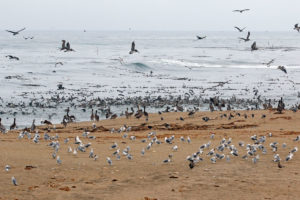Most summers, cold northerly winds off the Pacific Coast drive warm surface waters away from the shoreline and churn up colder, nutrient-rich waters from below. But this year, for reasons scientists don’t understand, that wind lacked its usual punch, resulting in weakened and delayed upwelling and a dramatic decrease in phytoplankton, the base of the marine food chain. Near-shore ocean temperatures registered at five to seven degrees above normal. Seabirds such as common murres and Brandt’s cormorants washed up dead along Monterey beaches in numbers four times higher than usual. Scientists recorded a 90 percent drop in nesting Cassin’s auklets on the Farallon Islands. And the California grunion, a fish so well-known in Southern California that it has its own website and toll-free hotline, appeared on beaches in Alameda and Marin.
Every year from late spring to early summer, hundreds of Southern Californians flock to the beaches after particularly high tides to witness the athletic and unusual mating habits of the grunion, a six-inch silvery fish known from south of Monterey Bay to northern Baja. On moonlit nights, large audiences watch as thousands of grunion fling themselves onto the sandy shore to mate, leaving their eggs buried in the sand for two weeks until the next full or new moon, when the high tide carries the hatching larvae out to sea.
Although the species was originally described based on a fish found in a San Francisco market in the mid-1800s, grunion have not been known to spawn north of Monterey Bay, says Pepperdine University biology professor and grunion specialist Karen Martin. However, if last summer is an indication of what’s to come, we won’t have to travel any farther than the Marin County shoreline or Alameda to see the grunion run.
At Dillon Beach near the mouth of Tomales Bay, one night last June, Willy Vogler found some fish wriggling on the beach where he works at Lawson’s Landing Campground. Unaware that the fish were unusual, he gathered about 18 of them to eat for dinner the following night. The fish turned out to be grunion, and the small group he had taken were likely scouts testing the sand before the ‚Äúrest of the school came boiling to shore for a free-for-all,‚Äù says Vogler.
Dale Roberts, a biologist at nearby Point Reyes National Seashore and Cordell Bank National Marine Sanctuary, went to Lawson’s Landing to observe and collect the spawning grunion in early July. His collected fish represent a range extension for grunion and now reside at Scripps Institution of Oceanography. ‚ÄúIt is possible that these grunion have been around but not recognized or correctly identified. On the other hand, the unusual ocean conditions that we are currently experiencing could be responsible for bringing grunion farther north than we generally find them,‚Äù says Roberts.
There’s more to this fish story. In 2001 the California Department of Fish and Game began finding grunion in their monthly trawl surveys taken around the Bay. They found six grunion in 2001, but the number increased each year until they counted 141 fish in 2004. Intrigued by these reports, Martin and Jody Zaitlin, a Port of Oakland ecologist, organized a team to look for spawning grunion on Bay beaches. They weren’t disappointed. Beneath a waning moon in late May, the ‚Äúgrunion greeters‚Äù spotted hundreds of grunion spawning at the surf’s edge at Crown Beach in Alameda. ‚ÄúBay grunion are a different population than coastal grunion,‚Äù says Martin. ‚ÄúWe are currently looking at whether or not the differences are enough to name them a distinct species.‚Äù Adult Bay grunion are about two inches smaller than their coastal cousins, and they stay close to the water’s edge when mating.
It’s possible that the Bay grunion have been here all along but escaped detection for several reasons: The fish look similar to jacksmelt; their spawning behavior is more subdued than that of their coastal cousins; and they come near shore only at night, when their only known Bay spawning ground, Crown Beach, is closed to the public.
Scientists are careful not to say that this summer’s temperatures and sea-life anomalies can be attributed to a change in the global climate system, since these events may represent a natural fluctuation in the ocean’s ecology. Meanwhile, researchers are taking notes, compiling data, and waiting to see what next year will bring.
To learn more about grunion, or to find out about becoming a grunion greeter next spring, visit www.grunion.org, contact grunion@pepperdine.edu, or call the toll-free grunion hotline at (877)GRUNION (478-6466).

.jpg)



-300x185.jpg)